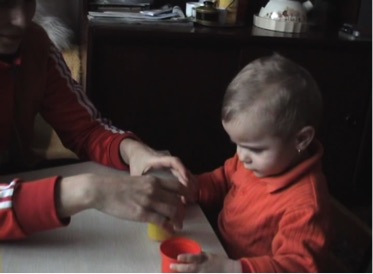
Ioana Goga
Center for Cognitive and Neural Studies
ioana_goga04@yahoo.com
website
 |
Ioana Goga Center for Cognitive and Neural Studies ioana_goga04@yahoo.com website |
| Participants: | 7 |
| Type of Study: | task |
| Location: | Romania |
| Media type: | video |
| DOI: | doi:10.21415/T53K5R |
Goga, I., & Billard, A. (2006). Development of goal-directed imitation, object manipulation and language in humans and robots. In M. A. Arbib (Ed.), Action to Language via the Mirror Neuron System. Cambridge University Press.
Goga, I. (2006). Educarea atentiei in dezvoltarea timpurie a limbajului si a abilitatilor de manipulare a obiectelor la copiii intre 1 si 3 ani. [Educating attention in early development of imitation, language and object manipulation abilities in human infants]. Bsc Degree Thesis, University Babes-Bolyai, Faculty of Psychology and Education Sciences, Cluj-Napoca.
Goga, I., Avram, L., and Bolos, A. (2006), Metodologii de cercetare a achizitiei limbajului utilizand baze de date electronice. Corpusuri romanesti cu vorbire adresata copiilor [The study of the acquisition of Romanian as L1 on the basis of electronic corpora]. Second National Psychology Conference, Cluj-Napoca, Romania, May 2006.
Greenfield, P., Nelson, K., & Saltzman, E., 1972. The development of rulebound strategies for manipulating seriated cups: a parallel between action and grammar. Cognitive Psychology, 3, 291-310.
MacWhinney, B. (1995). The CHILDES project : tools for analyzing talk. (2nd ed.). Hillsdale, N.J.: L. Erlbaum.
Zukow-Goldring, P., & Arbib, M. (2004). Educating attention: placing early lexical development within reach.
In accordance with TalkBank rules, any use of data from this corpus must be accompanied by at least one of the above references.
This work is part of a larger project that studies the mechanisms by which human infants acquire intentional behavior, imitation skills and language. The goal is to implement similar competences in autonomous robots, which can interact with people using natural, social cues in complex imitation scenarios. For more details on this project we refer the reader to Goga and Billard (2006).
The data for this corpus was collected during the observation of the structured interaction between pairs of human caregivers-infants, executing a seriated nesting cups task. The seriated nesting cups experiment was reported in Greenfield et al (1972) and consists first of a demonstration phase, during which the experimenter manipulates the cups to form a nest (i.e., insert all cups into one another using the most advanced strategy), followed by a spontaneous imitation phase, during which the child is left free to play with the cups.
Greenfield et al. (1972) report that children between 11 and 36 months of age exhibit different strategies, correlated to their developmental age, for combining cups of different sizes. Three manipulative strategies were identified and analyzed: (1) the pairing method, when a single cup is placed in/on a second cup; (2) the pot method, when two or more cups are placed in/on another cup; (3) the subassembly method, when a previously constructed structure consisting of two or more cups is moved as a unit in/on another cup or cup structure.
Each participant to the study gave informed consent for the use of their data. Real names have been used for all 7 children.
In our study, the original experiment of the seriated nesting cups task was modified in several ways. The demonstrator was replaced by the child caregiver, who was allowed to interact with the infant in three different conditions. During the first condition (free play) the infant and the caregiver were allowed to freely interact and communicate while playing with the nesting cups and two other toys.
During play the parent was instructed to play with the child like they do at home. They were given three nested cups larger then the cups from the experimental set, a duck toy and hippopotamus toy.
Before the imitation condition, the investigator demonstrated the seriated nesting cups task to the caregiver. The caregiver was instructed to watch carefully and to demonstrate identically to the child
In the second condition (imitation), the caregiver was instructed to demonstrate the seriated nesting cups to the infant, and she was allowed to interact in a limited manner with the infant during the demonstration and imitation periods.

Fig.2. During the imitation condition, the caregiver was
instructed to let the child imitate, without telling her how to
do the imitation task. During the guided condition, the caregiver
was told to use any means she has available in order to teach the
child to use the most advanced seriating strategy, i.e., the
subassembly.
In the third condition (guiding) the caregiver was instructed to guide the child attention during demonstration and imitation, using linguistic imperatives and gestures. The goal was to make the child use the most advanced seriating strategy.
Our objective was to investigate the means by which caregivers educate the attention of their infants during goal-directed action.
The participants to the study were blind to the hypothesis of the study. They were recruited from two kindergartens from Cluj-Napoca, Romania. They were all native speakers of Romanian language. All children were in good health and there were no records of learning or language disabilities, or developmental delays. Each child was observed in interaction with the caregiver which spends most of the time with her.
All data was collected by the principal investigator Ioana
Goga. The transcribing procedure was the following:
1. The
investigators trained themselves for coding with Speech Act Codes
using the New England Corpus (Snow) until the consistency with
the original files was above 60%.
2. The principal
investigator has transcribed and coded 80% of the corpus. The
second investigator Adriana Bolos has transcribed and coded 20%
of the corpus.
3. The second investigator has verified all
the transcriptions in the corpus and translated the %act lines
from Romanian to English.
4. The second investigator has
coded the entire corpus using the Speech Act Codes. The
consistency between the codes of the two investigators has been
computed for 20% of the corpus.
5. The first investigator
has checked all files, linked the video, and finalized the
corpus.
6. The consistency for transcription has been
computed for 20% of the corpus.
The consistency was computed separately for agreement between coders at the level of word, sentence, local event and Speech Act Codes.
| Level | Consistency | Word
transcription | Coders agreement = 86% | Cohen = 0.71 Sentence transcription | Coders agreement = 81% | Cohen = 0.62 Local events and overlapping | Coders agreement =
34% | SPA codes | Coders agreement = 66% | |
| COD | Function | Exemple
| &=ges:embody | Guide | *GDM: toate aşa cum sunt &=
ges:embody. | %act: GDM conduce mana lui CHI pentru a pune ansamblul 1+2+3+4 în cana 5. &=ges:show | Show | *CHI: ni &= ges:show
! | %act: CHI arată cana 5 roşie. &=point:object | Point | *GDM: pune albastru mic &=
point:cup în verde ! | %act: GDM indică cana 1 albastră. &= act:demo | Demonstrate | *CAR: 0
&=act:demo. | %act: CAR scoate canile câte una şi le pune în ordine pe masă. &= gaze:object | Gaze
object | *CHI: &= gaze:cup roşie. | %act: CHI priveşte la cană. CHI priveşte înapoi la cănile din mână. &=
gaze:other | Gaze the face of the other person. | *CHI: 0 &=
gaze:other . | %act: CHI pune cana 5 roşie peste cana 3 galbenă. CHI se uită la CAR. &= gaze:follow | Follow the
gaze of the other. | *CHI: 0 &= gaze:follow. | %act: CHI priveşte la cana 1. |
Warnings: No attention has been paid to the correct transcription of speech errors. The dialectal variation has been transcribed but not marked.
Dialectical forms have been transcribed, but no special attention has been paid to the transcription or coding of this information.
| Nr | Child/sex | Age (months) | MLU | Interacting with | Condition | Files | 1. | Andu
/m | 22 | 22 | Mother and Father | Imitation
| Guide Andu-Imitation.cha | Andu-Guidance.cha 2. | Ali/m | 18 | 18 | Grandmother | Imitation | Guide Play Ali-Imitation.cha | Ali-Guidance.cha Ali- FreePlay.cha 3. | Anda/f | 38 | 38 | Mother | Imitation
| Guide Play with another infant Anda-Imitation.cha | Anda-Guidance.cha Anda_Larisa. cha 4. | Darius/m | 36 | 36 | Mother | Imitation | Guide Play Darius-Imitation.cha | Darius-Guidance.cha Darius3.cha 5. | Deni/f | 27 | 27 | Day
caretaker | Imitation | Guide Play Denisa-Imitation.cha<
br>Denisa-Guidance.cha | Denisa-FreePlay.cha 6. | Luisa/f | 14 | 14 | Mother | Imitation | Guide Luisa-Imitation.cha | Luisa-Guidance.cha 7. | Mela/f | 38 | 38 | Mother | Imitation | Guide< td>Mela1.cha Mela2.cha |
Special conditions:
For the following files the English translation of the speech is provided:
This project was partially supported by the Swiss National Science Foundation through the SNF Professorships Program awarded to Prof. Aude Billard from Laboratory for Autonomous Systems, Lausanne, Switzerland.